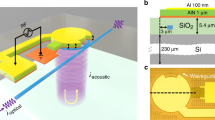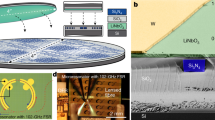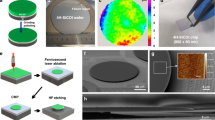Abstract
Integrated photonics enables signal synthesis, modulation and conversion using photonic integrated circuits (PICs). Many materials have been developed, among which silicon nitride (Si3N4) has emerged as a leading platform particularly for nonlinear photonics. Low-loss Si3N4 PICs have been widely used for frequency comb generation, narrow-linewidth lasers, microwave photonics and photonic computing networks. Yet, among all demonstrated functionalities for Si3N4 integrated photonics, optical non-reciprocal devices such as isolators and circulators have not been achieved. Conventionally, they are realized based on the Faraday effect of magneto-optic materials under an external magnetic field; however, it has been challenging to integrate magneto-optic materials that are not compatible with complementary metal–oxide–semiconductors and that require bulky external magnet. Here we demonstrate a magnetic-free optical isolator based on aluminium nitride (AlN) piezoelectric modulators monolithically integrated on low-loss Si3N4 PICs. The transmission reciprocity is broken by spatio-temporal modulation of a Si3N4 microring resonator with three AlN bulk acoustic wave resonators that are driven with a rotational phase. This design creates an effective rotating acoustic wave that allows indirect interband transition in only one direction among a pair of strongly coupled optical modes. A maximum of 10 dB isolation is achieved under 300 mW total radiofrequency power applied to three actuators, with minimum insertion loss of 0.1 dB. An isolation bandwidth of 700 MHz is obtained, determined by the optical resonance linewidth. The isolation remains constant over nearly 30 dB dynamic range of optical input power, showing excellent optical linearity. Our integrated, linear, magnetic-free, electrically driven optical isolator could be a key building block for integrated lasers and optical interfaces for superconducting circuits.
This is a preview of subscription content, access via your institution
Access options
Access Nature and 54 other Nature Portfolio journals
Get Nature+, our best-value online-access subscription
$29.99 / 30 days
cancel any time
Subscribe to this journal
Receive 12 print issues and online access
$209.00 per year
only $17.42 per issue
Buy this article
- Purchase on Springer Link
- Instant access to full article PDF
Prices may be subject to local taxes which are calculated during checkout





Similar content being viewed by others
Data availability
The code and data used to produce the plots within this work are available on Zenodo (https://doi.org/10.5281/zenodo.5120854). All other data used in this study are available from the corresponding authors on reasonable request.
References
Xiang, C. et al. Narrow-linewidth iii–v/Si/Si3N4 laser using multilayer heterogeneous integration. Optica 7, 20–21 (2020).
Xiang, C. et al. Laser soliton microcombs heterogeneously integrated on silicon. Science 373, 99–103 (2021).
Wang, C. et al. Integrated lithium niobate electro-optic modulators operating at CMOS-compatible voltages. Nature 562, 101–104 (2018).
He, M. et al. High-performance hybrid silicon and lithium niobate Mach–Zehnder modulators for 100 gbit s–1 and beyond. Nat. Photon.13, 359–364 (2019).
Tian, H. et al. Hybrid integrated photonics using bulk acoustic resonators. Nat. Commun. 11, 3073 (2020).
Liu, J. et al. Monolithic piezoelectric control of soliton microcombs. Nature 583, 385–390 (2020).
Tadesse, S. A. & Li, M. Sub-optical wavelength acoustic wave modulation of integrated photonic resonators at microwave frequencies. Nat. Commun. 5, 5402 (2014).
Shao, L. et al. Microwave-to-optical conversion using lithium niobate thin-film acoustic resonators. Optica 6, 1498–1505 (2019).
Zhang, M., Wang, C., Cheng, R., Shams-Ansari, A. & Lončar, M. Monolithic ultra-high-q lithium niobate microring resonator. Optica 4, 1536–1537 (2017).
Chang, L. et al. Ultra-efficient frequency comb generation in algaas-on-insulator microresonators. Nat. Commun. 11, 1331 (2020).
Xuan, Y. et al. High-q silicon nitride microresonators exhibiting low-power frequency comb initiation. Optica 3, 1171–1180 (2016).
Ji, X. et al. Ultra-low-loss on-chip resonators with sub-milliwatt parametric oscillation threshold. Optica 4, 619–624 (2017).
Liu, J. et al. High-yield, wafer-scale fabrication of ultralow-loss, dispersion-engineered silicon nitride photonic circuits. Nat. Commun. 12, 2236 (2021).
Moss, D. J., Morandotti, R., Gaeta, A. L. & Lipson, M. New CMOS-compatible platforms based on silicon nitride and hydex for nonlinear optics. Nat. Photon. 7, 597–607 (2013).
Gaeta, A. L., Lipson, M. & Kippenberg, T. J. Photonic-chip-based frequency combs. Nat. Photon. 13, 158–169 (2019).
Kippenberg, T. J., Gaeta, A. L., Lipson, M. & Gorodetsky, M. L. Dissipative Kerr solitons in optical microresonators. Science 361, eaan8083 (2018).
Wang, C. et al. Monolithic lithium niobate photonic circuits for Kerr frequency comb generation and modulation. Nat. Commun. 10, 978 (2019).
He, Y. et al. Self-starting bi-chromatic LiNbO3 soliton microcomb. Optica 6, 1138–1144 (2019).
Jung, H., Xiong, C., Fong, K. Y., Zhang, X. & Tang, H. X. Optical frequency comb generation from aluminum nitride microring resonator. Opt. Lett. 38, 2810–2813 (2013).
Liu, X. et al. Integrated high-q crystalline aln microresonators for broadband kerr and raman frequency combs. ACS Photon. 5, 1943–1950 (2018).
Pu, M., Ottaviano, L., Semenova, E. & Yvind, K. Efficient frequency comb generation in AlGaAs-on-insulator. Optica 3, 823–826 (2016).
Jin, W. et al. Hertz-linewidth semiconductor lasers using cmos-ready ultra-high-Q microresonators. Nat. Photon 15, 346–353 (2021).
Srinivasan, K. & Stadler, B. J. H. Magneto-optical materials and designs for integrated TE- and TM-mode planar waveguide isolators: a review [invited]. Opt. Mater. Express 8, 3307–3318 (2018).
Bi, L. et al. On-chip optical isolation in monolithically integrated non-reciprocal optical resonators. Nat. Photon. 5, 758–762 (2011).
Huang, D. et al. Electrically driven and thermally tunable integrated optical isolators for silicon photonics. IEEE J. Sel. Top. Quantum Electron. 22, 271–278 (2016).
Yan, W. et al. Waveguide-integrated high-performance magneto-optical isolators and circulators on silicon nitride platforms. Optica 7, 1555–1562 (2020).
Awschalom, D. et al. Development of quantum interconnects (QuICs) for next-generation information technologies. PRX Quantum 2, 017002 (2021).
Fang, K., Yu, Z. & Fan, S. Realizing effective magnetic field for photons by controlling the phase of dynamic modulation. Nat. Photon. 6, 782–787 (2012).
Tzuang, L. D., Fang, K., Nussenzveig, P., Fan, S. & Lipson, M. Non-reciprocal phase shift induced by an effective magnetic flux for light. Nat. Photon. 8, 701–705 (2014).
Kim, S., Sohn, D. B., Peterson, C. W. & Bahl, G. On-chip optical non-reciprocity through a synthetic hall effect for photons. APL Photon. 6, 011301 (2021).
Dostart, N., Gevorgyan, H., Onural, D. & Popović, M. A. Optical isolation using microring modulators. Opt. Lett. 46, 460–463 (2021).
Fan, L. et al. An all-silicon passive optical diode. Science 335, 447–450 (2012).
Peng, B. et al. Parity–time-symmetric whispering-gallery microcavities. Nat. Phys. 10, 394–398 (2014).
Chang, L. et al. Parity–time symmetry and variable optical isolation in active–passive-coupled microresonators. Nat. Photon. 8, 524–529 (2014).
Bino, L. D. et al. Microresonator isolators and circulators based on the intrinsic nonreciprocity of the Kerr effect. Optica 5, 279–282 (2018).
Hua, S. et al. Demonstration of a chip-based optical isolator with parametric amplification. Nat. Commun. 7, 13657 (2016).
Yang, K. Y. et al. Inverse-designed non-reciprocal pulse router for chip-based LiDAR. Nat. Photon. 14, 369–374 (2020).
Cao, Q.-T. et al. Reconfigurable symmetry-broken laser in a symmetric microcavity. Nat. Commun. 11, 1136 (2020).
Shen, Z. et al. Experimental realization of optomechanically induced non-reciprocity. Nat. Photon. 10, 657–661 (2016).
Ruesink, F., Miri, M.-A., Alù, A. & Verhagen, E. Nonreciprocity and magnetic-free isolation based on optomechanical interactions. Nat. Commun. 7, 13662 (2016).
Shen, Z. et al. Reconfigurable optomechanical circulator and directional amplifier. Nat. Commun. 9, 1797 (2018).
Ruesink, F., Mathew, J. P., Miri, M.-A., Alù, A. & Verhagen, E. Optical circulation in a multimode optomechanical resonator. Nat. Commun. 9, 1798 (2018).
Kang, M. S., Butsch, A. & Russell, P. S. J. Reconfigurable light-driven opto-acoustic isolators in photonic crystal fibre. Nat. Photon. 5, 549–553 (2011).
Poulton, C. G. et al. Design for broadband on-chip isolator using stimulated Brillouin scattering in dispersion-engineered chalcogenide waveguides. Opt. Express 20, 21235–21246 (2012).
Dong, C.-H. et al. Brillouin-scattering-induced transparency and non-reciprocal light storage. Nat. Commun. 6, 6193 (2015).
Kim, J., Kuzyk, M. C., Han, K., Wang, H. & Bahl, G. Non-reciprocal Brillouin scattering induced transparency. Nat. Phys. 11, 275–280 (2015).
Merklein, M. et al. On-chip broadband nonreciprocal light storage. Nanophotonics 10, 75–82 (2021).
Shi, Y., Yu, Z. & Fan, S. Limitations of nonlinear optical isolators due to dynamic reciprocity. Nat. Photon. 9, 388–392 (2015).
Yu, Z. & Fan, S. Complete optical isolation created by indirect interband photonic transitions. Nat. Photon. 3, 91–94 (2009).
Lira, H., Yu, Z., Fan, S. & Lipson, M. Electrically driven nonreciprocity induced by interband photonic transition on a silicon chip. Phys. Rev. Lett. 109, 033901 (2012).
Sounas, D. L. & Alù, A. Angular-momentum-biased nanorings to realize magnetic-free integrated optical isolation. ACS Photon. 1, 198–204 (2014).
Shi, Y., Lin, Q., Minkov, M. & Fan, S. Nonreciprocal optical dissipation based on direction-dependent Rabi splitting. IEEE J. Sel. Top. Quantum Electron. 24, 1–7 (2018).
Kittlaus, E. A., Otterstrom, N. T., Kharel, P., Gertler, S. & Rakich, P. T. Non-reciprocal interband Brillouin modulation. Nat. Photon. 12, 613–619 (2018).
Sohn, D. B., Kim, S. & Bahl, G. Time-reversal symmetry breaking with acoustic pumping of nanophotonic circuits. Nat. Photon. 12, 91–97 (2018).
Kittlaus, E. A. et al. Electrically driven acousto-optics and broadband non-reciprocity in silicon photonics. Nat. Photon. 15, 43–52 (2021).
Fan, L. et al. Superconducting cavity electro-optics: a platform for coherent photon conversion between superconducting and photonic circuits. Sci. Adv. 4, eaar4994 (2018).
Balram, K. C., Davanço, M., Lim, J. Y., Song, J. D. & Srinivasan, K. Moving boundary and photoelastic coupling in gaas optomechanical resonators. Optica 1, 414–420 (2014).
Stanfield, P. R., Leenheer, A. J., Michael, C. P., Sims, R. & Eichenfield, M. CMOS-compatible, piezo-optomechanically tunable photonics for visible wavelengths and cryogenic temperatures. Opt. Express 27, 28588–28605 (2019).
Lukens, J. M. & Lougovski, P. Frequency-encoded photonic qubits for scalable quantum information processing. Optica 4, 8–16 (2017).
Marin-Palomo, P. et al. Microresonator-based solitons for massively parallel coherent optical communications. Nature 546, 274 (2017).
Moille, G. et al. Broadband resonator-waveguide coupling for efficient extraction of octave-spanning microcombs. Opt. Lett. 44, 4737–4740 (2019).
Sohn, D., Örsel, O. E. & Bahl, G. Electrically driven linear optical isolation through phonon mediated autler-townes splitting. Preprint at https://arxiv.org/abs/2104.04803 (2021).
Blésin, T., Tian, H., Bhave, S. & Kippenberg, T. Quantum coherent microwave-optical transduction using high overtone bulk acoustic resonances. Preprint at https://arxiv.org/abs/2103.00471 (2021).
Pirro, M. et al. Characterization of dielectric and piezoelectric properties of ferroelectric alscn thin films. In 2021 IEEE 34th International Conference on Micro Electro Mechanical Systems (MEMS) 646–649 (IEEE, 2021).
Acknowledgements
This work was supported by US National Science Foundation’s RAISE TAQS program under grant no. PHY 18-39164, by NSF QISE-Net under grant no. DMR 17-47426, by the Air Force Office of Scientific Research under award no. FA8655-20-1-7009, by funding from the EU H2020 research and innovation programme under grant agreement no. 732894 (HOT), and by Swiss National Science Foundation under grant agreement no. 176563 (BRIDGE). Samples were fabricated in the EPFL center of MicroNanoTechnology (CMi), and Birck Nanotechnology Center at Purdue University. AlN deposition was performed at Plasma-Therm LLC. We thank Y. Shi for valuable discussions.
Author information
Authors and Affiliations
Contributions
H.T. and J.L. designed the devices. J.L., H.T. and R.N.W. developed the process and fabricated the samples, with the assistance from J.H.. H.T. performed the experiment and simulations, and analysed the data. A.S. performed the experiment on the overcoupled device with the assistance from T.B.. H.T. and J.L. wrote the manuscript, with input from others. S.A.B and T.J.K supervised the collaboration.
Corresponding authors
Ethics declarations
Competing interests
The authors declare no competing interests.
Additional information
Peer review information Nature Photonics thanks Chun-Hua Dong and the other, anonymous, reviewer(s) for their contribution to the peer review of this work.
Publisher’s note Springer Nature remains neutral with regard to jurisdictional claims in published maps and institutional affiliations.
Supplementary information
Supplementary Information
Supplementary Figs. 1–10, Tables 1 and 2, Notes 1–11.
Supplementary Video 1
Experimental demonstration of optical transmission spectrum of TE and TM light in forwards and backwards directions.
Supplementary Video 2
Unidirectional transmission of optical pulses with 10 ns pulse width.
Rights and permissions
About this article
Cite this article
Tian, H., Liu, J., Siddharth, A. et al. Magnetic-free silicon nitride integrated optical isolator. Nat. Photon. 15, 828–836 (2021). https://doi.org/10.1038/s41566-021-00882-z
Received:
Accepted:
Published:
Issue Date:
DOI: https://doi.org/10.1038/s41566-021-00882-z
This article is cited by
-
Quantized topological pumping in Floquet synthetic dimensions with a driven dissipative photonic molecule
Nature Physics (2024)
-
An optoacoustic field-programmable perceptron for recurrent neural networks
Nature Communications (2024)
-
Integrated passive nonlinear optical isolators
Nature Photonics (2023)
-
Optomechanical ring resonator for efficient microwave-optical frequency conversion
Nature Communications (2023)
-
Integrated electro-optic isolator on thin-film lithium niobate
Nature Photonics (2023)



